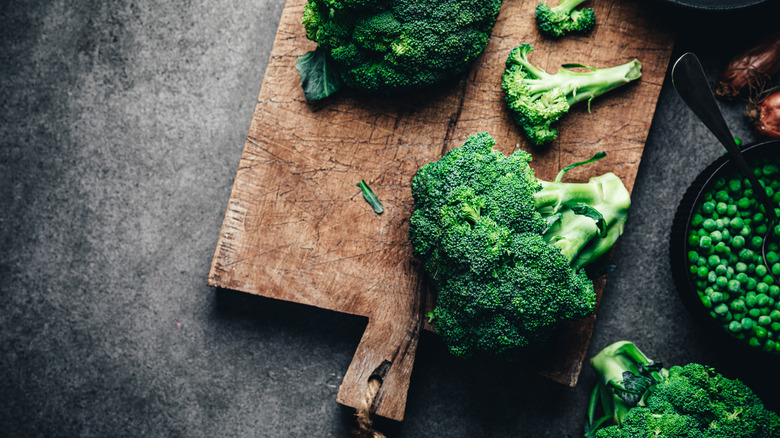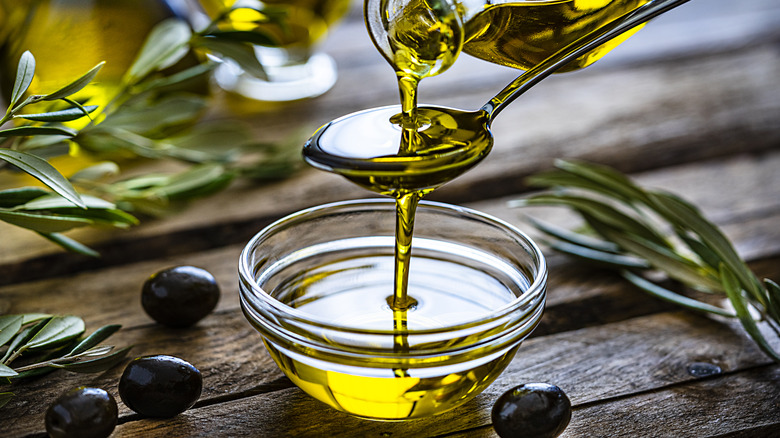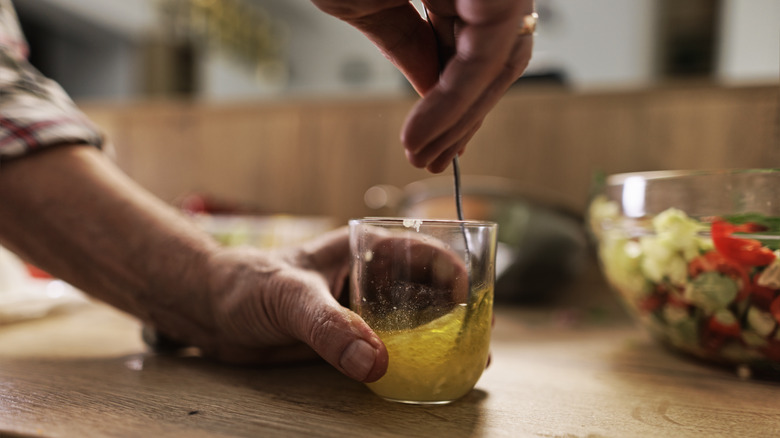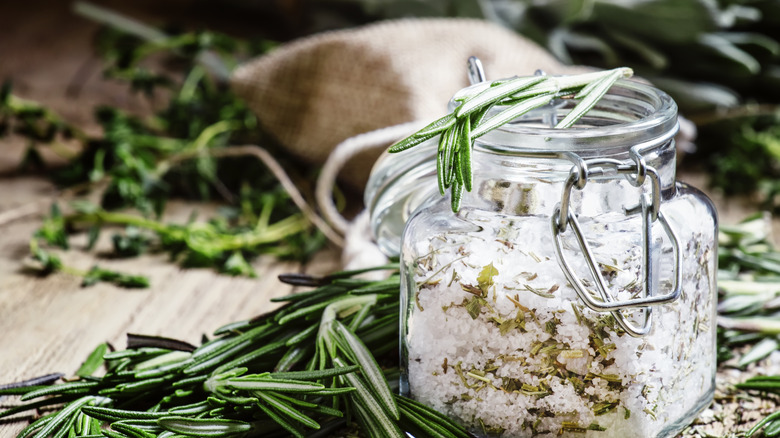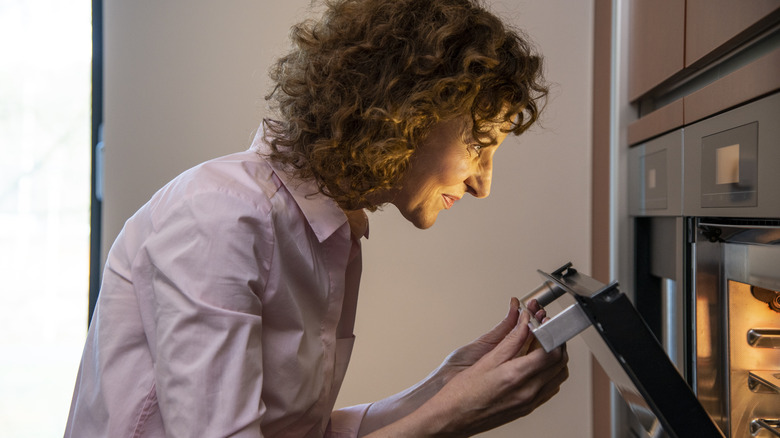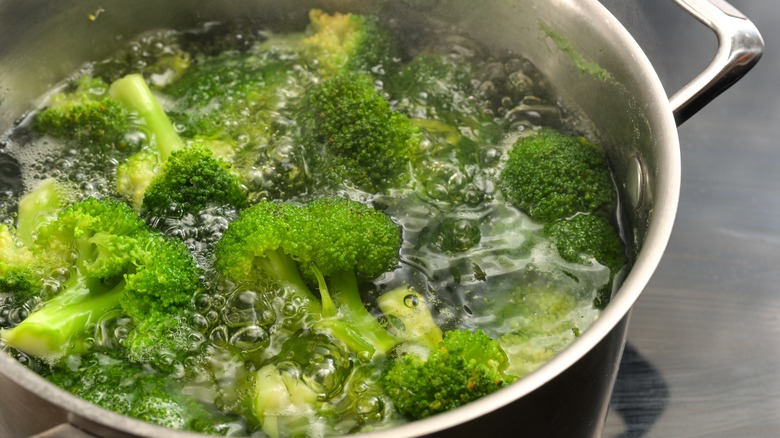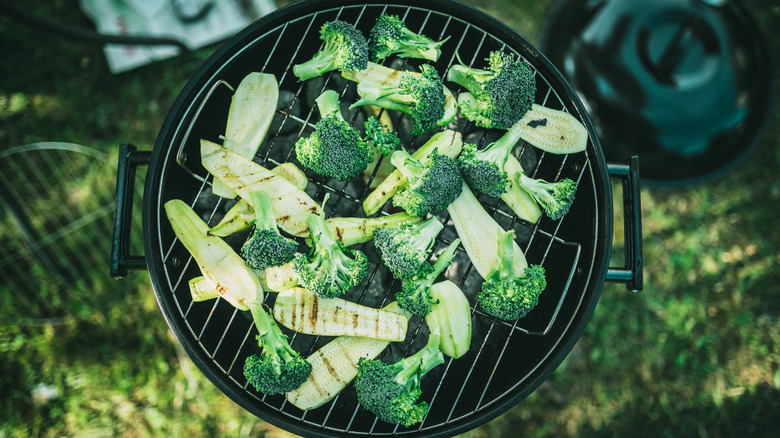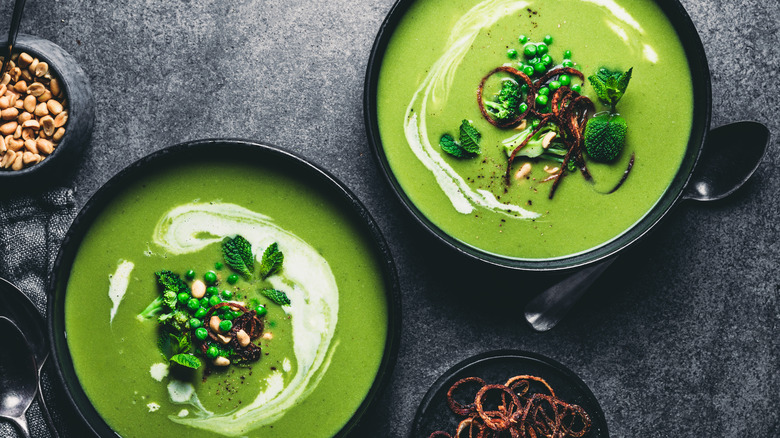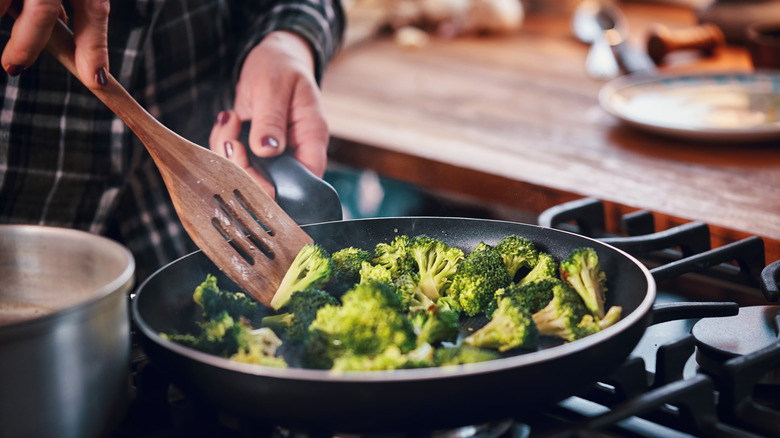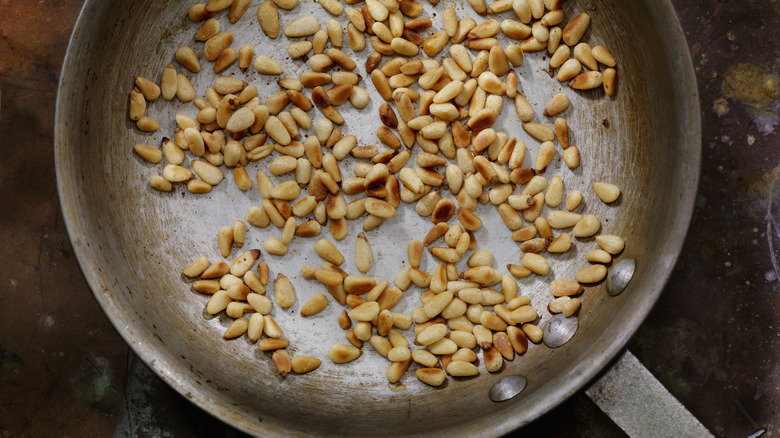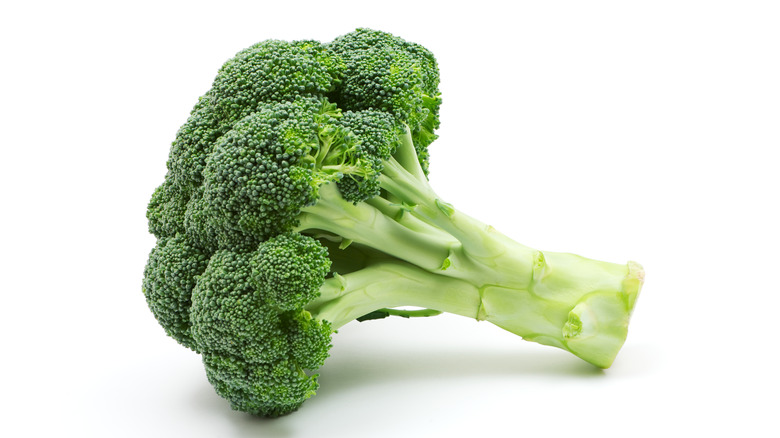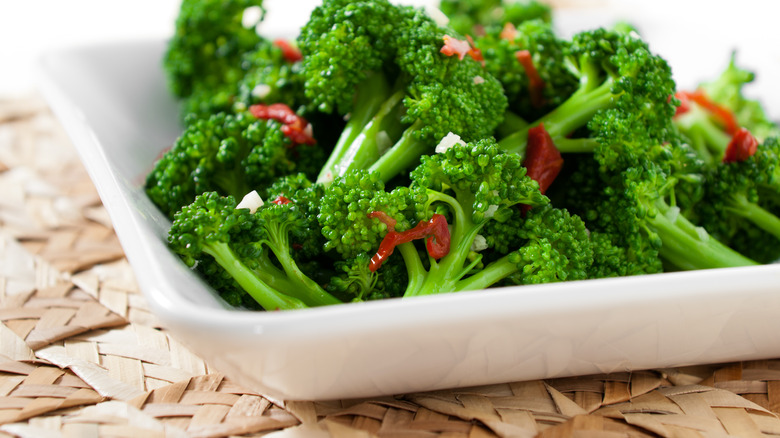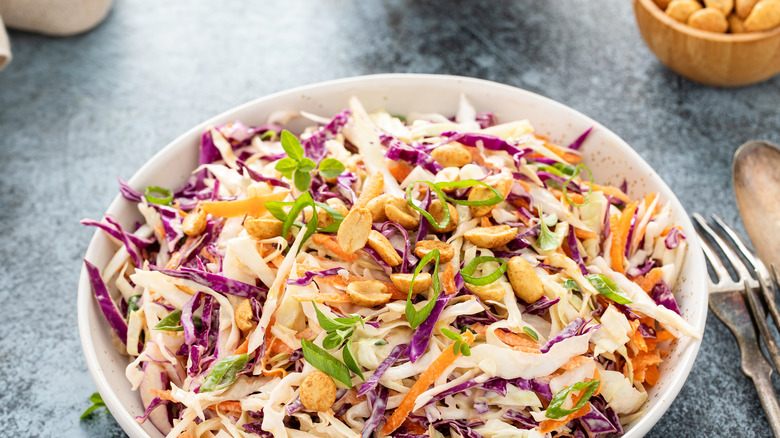Celebrity Chef Pro-Tips For Better Broccoli
Broccoli is famous for being a child's favorite veggie ... to turn up their nose at. Even many grownups will tell you that they don't appreciate its grassy flavor and fibrous texture. But this brassica doesn't need to be unpleasant, and as for texture, it's all about the preparation.
Prepared correctly, broccoli can be tender, sweet, and a wonderful carrier of other flavors. It makes the perfect accompaniment to meat, tofu, noodles, and curry, and the little buds in its florets are perfect for soaking up sauce. And it is super healthy to boot, loaded with potassium, beta carotene, vitamin A, and more.
Of course, none of that matters if it doesn't taste good. That's where your favorite cooks come in. Each tip below comes from a celebrity chef whose work is beyond reproach and whose ability to transform ordinary ingredients into dishes is well-known. Not only will you learn each hack for better broccoli, but you'll also learn why it works and exactly how to apply it in your own kitchen.
Rachel Ray: Go heavy on the EVOO
When shooting for perfect roasted vegetables, friendly home cooking aficionado Rachel Ray has a simple but highly effective tip for you: use more olive oil. Many cooks advise 3-4 tablespoons per pound of broccoli, which equals about 3 stalks, while some just tell you to "drizzle." But Rachel says MORE!
Olive oil is an amazing ingredient, after all. This versatile whole food stretches back 6,000 years to some of the earliest Mediterranean civilizations, when olives were first pressed for their oil and was used in ceremonies and lamps as well as cooking.
Today, we love olive oil because it makes roasted vegetables taste sweeter and leaves a rich mouthfeel on the palate (important for a food that otherwise might involve a lot of thankless chewing). The fatty acids present in olive oil also help keep both the oil and food with which it comes into contact stable at high temperatures, preventing your veggies from scorching in the oven or pan.
How much oil are we talking about here? Rachel Ray advises you to use 3 tablespoons of olive oil for every head of broccoli. Yes, every head, not a bunch of them rubber-banded together (note that she does include the stalk in these calculations). This might seem like a lot, but it will make your broccoli so much more tender, delicious, and some might even say edible. Pour it on before roasting with just a little salt, pepper, garlic and boom: heaven.
Emeril Lagasse: Dress before and after
Most people oil their broccoli before sticking it in the oven or dry roast it and dress after, but Emeril Lagasse does both. if you're feeling adventurous, you can try experimenting with when to add oil for the best possible flavor, as it turns out that dry roasting and then oiling afterward is quite effective.
As far as Emeril is concerned, adding oil at the beginning is just fine. He advises a max of 4 tablespoons per 1½ pounds, but as Rachel teaches, you can safely up that to get the best flavor. Pro tip: Follow the 3 tablespoons per head rule, but if you want to eyeball it, just make sure every floret and piece of stalk is glistening before you stick it in the oven.
Once you remove your broccoli, toss it with a teaspoon of garlic, ¼ cup of parmesan, and the juice and zest of half a lemon for every 1½ pounds you use. Since you're not adding much liquid at the end, you can feel safe being quite liberal before baking.
David Chang: Use seasoning salts
No one needs to tell you that cooking broccoli without salt is just straight nuts. Unless your doctor has advised you to skip the sodium for health reasons, there's no need to cut down on the salt in food. According to the United States Food & Drug Administration, more than 70% of the sodium in our diets comes from packaged food, not the salt we add to our own home-cooked meals. The best way to stay healthy is to avoid packaged goods wherever possible and salt to taste at the stove and table.
That said, there's no reason good old sodium chloride (think the stuff that comes out of the umbrella girl canister) is the only way you can add salt to broccoli. Chef David Change uses seasoning salts to bring zest to his broccoli dishes. You can try trusty Tajín for a chili-lime kick, or you can opt for salts laden with lemon, garlic, Mediterranean herbs, vegan chicken flavor, or just about anything else that strikes your fancy.
You can even make your own seasoning salts out of cooking scraps. Regular throwaways such as celery leaves, beet peels, onion and garlic skins, citrus peels, tomato skins, and old parsnip skins are all appropriate choices for seasoning salt. You can store the seasonings in the freezer until you're ready, then dry them out in the dehydrator, air fryer, or oven and blend them up with table salt. You can even use chicken skins.
Sunny Anderson: Cook on a lower heat
Most recipes for roasted broccoli call for you to bake broccoli at 400-425 degrees Fahrenheit, but this can make broccoli dry out. It also leads to a greater incidence of char. While a little bit is nice on the ends of oven-tender broccoli florets, a lot is not so nice. Plus, it's bad for you. According to Columbia University's Irving Medical Center, charring in vegetables can produce carcinogens, including benzopyrene.
For tender broccoli without the health threat, try cooking at 350 F like Sunny Anderson does. Famous for her dishes that mix whole food ingredients with classic comfort food tastes, she matches the low-and-slow method with traditional garlic, lemon, olive oil, and salt-and-pepper flavors. This tenderizes broccoli more effectively, softening it inside before it burns on the outside.
If you're worried that a lower temperature might compromise the crispiness, or if you don't have time for the longer 30- to 40-minute cooking times (as opposed to about 20 minutes at higher temps), you can make a few adjustments. The secret ingredient for the crispiest vegetables is cornstarch, so add a tablespoon of cornstarch per pound of veggies to your oil before pouring over veggies and baking. If you're in a hurry, roast vegetables quicker by chopping them more finely.
Giada de Laurentiis: Blanch it conservatively
Many people over-blanch, waiting until the broccoli looks the "right" color for eating before removing it from the water. But by that time, it's too late. You need to pay close attention when blanching vegetables because the right blanching time varies a lot per veggie. For instance, Brussels sprouts require 3-5 minutes, while onion slices need a mere 10-15 seconds before they're overdone. And when that happens, you are essentially left with mush, which won't hold up to the next cooking stage.
For broccoli, the typical method of preparation using blanching is to cook them in a water bath for a few minutes before removing them and sautéing them in a pan with flavorings. However, blanching is a critical skill if you like making broccoli salads. It's also a good trick to make broccoli palatable on a crudité platter.
Famous Italian chef Giada de Laurentiis recommends you blanch conservatively, pulling broccoli out the second it turns bright green. This should take 1-2 minutes in a pot of boiling water. The second step in blanching is to transfer the broccoli immediately to an ice bath, prepared and standing by. Fish out your florets using a slotted spoon (you don't want to carry hot water into the ice bath) and plunge them into the cold water ASAP to stop the cooking ... et voilà! Your broccoli is all ready for its next step, whether that's salad, sautéing, or a turn on the grill.
The Neelys: Grill it
Grilled broccoli isn't a particularly common recipe for home chefs, but it's delicious, especially combined with skills like correct blanching. Pat and Gina Neely, better known as the Neelys from their excellent cooking Show "Down Home With the Neelys," are expert grillers. Their episodes feature lots of time outdoors at the barbecue, where they do up everything from meats to veggies to even fruits such as pineapple.
Suffice it to say, broccoli has not escaped their enthusiasm. Grilling broccoli makes it tender and adds a smoky flavor, especially if you're using charcoal. The Neelys recommend blanching then marinating in a sauce of olive oil, red pepper flakes, white wine vinegar, garlic, and salt and pepper. They use a homemade dry rub as well. Want your own recipe? Here's an easy three-ingredient dry rub that includes nothing more than garlic salt, paprika, and brown sugar. You can skip the rub part, though, simply adding it to your liquids and letting the broccoli sit for 30 minutes before grilling.
Nigella Lawson: Use frozen for soup
Broccoli cheese soup is a true classic. While Americans tend to opt for the broccoli cheddar combo, which you can usually find at any grocery store, often fresh, the Brits love their Stilton. Stilton and broccoli soup is a delicious Nigella Lawson recipe, but she has a surprising piece of advice to offer: Don't use fresh broccoli.
It's true that most chefs recommend you use fresh veggies whenever you can, and common wisdom has it that just off-the-turnip-truck veg contains more of the important vitamins and minerals our bodies need. However, a study published in the Journal of Agricultural and Food Chemistry found that fresh and frozen vegetables are often comparable in nutrition, and in some cases, frozen veggies win out. This is likely because they are frozen at the peak of ripeness, when their nutrients are most potent, while fresh vegetables degrade after picking. By the time you get your hands on it, you don't know how long it has sat around.
Nigella believes that frozen broccoli is actually better for making soup than fresh (and it's certainly easier). Because frozen broccoli has to be blanched before freezing, it's already partially cooked. This diminishes the amount of time you have to spend at a hot stove, and it removes all the prep entirely since frozen broccoli is already washed and trimmed. Next time you go to make broccoli soup of any kind, skip the produce section and head to frozen foods.
Gordon Ramsay: Dry blanched or boiled broccoli with a hot pan
Blanching broccoli is an important step in many broccoli recipes, as discussed above for sautéing, grilling, and making broccoli salad. However, once you finish your broccoli off in an ice bath to stop the cooking, you may find it's a little wet. This leaves you with a conundrum. Don't put it in a water bath, as it will continue to get darker and eventually mushy. Do, and you'll stop the steaming process that naturally dries out your veggies.
Gordon Ramsay has the answer: Simply throw it in a dry, hot pan. This dries out the broccoli quickly without adding any moisture to it, so definitely don't add any oil. You can even add your broccoli to a dry pan to get rid of liquid, then drizzle with oil after if you like.
One caveat, though. If you're adding cooked broccoli to a sauté pan with other garden items, remember to follow the "ground-up" rule. You should cook them from the ground up because the toughest vegetables are roots, followed by those you eat straight from the ground (e.g., broccoli or cabbage), followed by fruiting bodies such as peppers and eggplants. This will help ensure that no one gets mushy and no one goes undercooked. Broccoli lies right in the middle, so if you are using the same pan with lots of vegetables, dry broccoli out before proceeding with the rest of your ground-up crew.
Ina Garten: Try some pine nuts
Ina Garten is all about the "good" stuff. Good olive oil and good butter and good English Stilton. (Has anyone else ever wondered, given its price, if there's a "bad" English Stilton?) So naturally, the fact that she loves pine nuts is no surprise to anyone because they have to be about the most expensive, tiny, unnecessary thing in the entire grocery store.
And yet, Ina is onto something because they're truly delicious. Besides, although broccoli has a nice flavor, it sure can use an assist. The Barefoot Contessa's recipe with pine nuts and parmesan is just that. She uses a traditional roasting method at 425 F (which you are free to adjust to Sunny's low-and-slow method for more tender broccoli if you don't like the al dente effect), seasoning prepared florets (no stalks) with some simple garlic, olive oil, and salt and pepper.
Afterward, though, is when the magic happens. She tosses the cooked broccoli with parmesan, basil, lemon juice, and pine nuts for the perfect buttery crunch. Just make sure to serve this dish right away, as the flavors are best piping hot out of the oven.
Lorraine Pascale: Use the stalk in soups
Ina's recipe above, and indeed most recipes for oven-roasted or sautéed broccoli, call for you to prepare the broccoli florets and discard the stalks. But this is a mistake because broccoli stalks are creamy, starchy, and delicious. In fact, they're the tenderest part of the broccoli if you do them right, removing the tough peel and working with the pale green flesh inside.
Even if you don't have time to lovingly peel them, Lorraine Pascale says they have a role to play in soups along with the florets. If you don't have frozen broccoli on hand or have accumulated a collection of stalks that you don't want to feed to the compost, then this is a great tip. Simply combine with potato and leek, chicken stock, and Stilton or Roquefort (see, the Brits really love blue cheese).
Even if you're not making soup, don't throw out those stems! You can peel them (remember to wash them first), dice them, and use them in a stir fry.
Jamie Oliver: Use infused butter with steamed veg
Heard of infused olive oil? Well, infused butter exists, too, and it's basically the best thing ever created by humankind. Do note that in this case, "infused" doesn't mean the traditional process of infusing one flavor into another by prolonged soaking, as with chilis or garlic in olive oil. Rather, if you look up infused butter online (and wade through the hearty percentage of hits that are about weed), you'll see the same advice every time: Chop things small, then mix them with butter.
This is exactly the approach celebrity chef Jamie Oliver takes to his broccoli. Like Ina, Jamie believes in helping the flavor of broccoli along, such as with his infused butter made with lemon and clementine zest, red chili, and fresh thyme. Mixed generously into softened butter and used as a topping on steamed broccoli, it is delicious.
If you're feeling frisky, mix in some peas and Brussels sprouts with your broccoli. Just make sure when you're steaming to use the "ground-up" method and first add the sprouts, then the broccoli, and then the peas to your steamer basket in deference to their relative delicacy. If possible, use tiered baskets, which will keep everything structurally sound and at the correct distance from the heat while cooking.
Guy Fieri: Put the stems in slaw
Broccoli stems are a cook's dilemma. They're clearly good food, with nice fresh green meat inside the tough external skin. But the pieces of broccoli that come from the stem don't have the same consistency as the florets, and they're annoying to get to. Are they really worth the effort?
Guy Fieri says yes. He advocates putting broccoli stems in a creamy coleslaw along with fennel, red and green cabbage, carrot, and sweet onion. Add in honey, cider vinegar, Dijon mustard, cayenne, tarragon, and salt and pepper, and you have a dreamy barbecue side dish.
All you have to do is wash the broccoli stems (which you presumably already did before denuding them of florets) and remove the tough outer peel, which is a lot like a cow's cud. Then, julienne them, which you can do with a sharp knife by hand or with a mandolin. Every good chef should have a mandolin, which helps you slice fruits and vegetables finely or shave with precision. (If you ever want to make your own potato chips, for instance, this is a must.) A proper julienne is ⅛ inches or slightly smaller.
